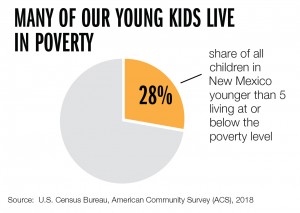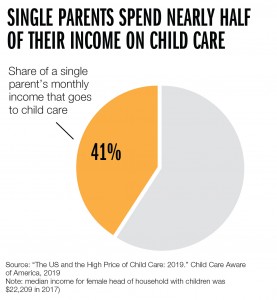The Case for Strong Investments in ECCE in New Mexico
Download this policy brief (Jan. 2020; 4 pages; pdf)
All New Mexico children deserve to have the opportunities in their most formative years that will help them to thrive and succeed in life.
Unfortunately too many kids in New Mexico lack access to such opportunities either because their hard-working families cannot afford them or programs are simply not available in their communities. The impact and prevalence of poverty and adverse childhood experiences (ACEs) are high in New Mexico, and are detrimental to childrens’ health and learning throughout their life. Early childhood programs provide safe, nurturing environments to prevent and alleviate the impact of ACEs.
New Mexico needs to invest heavily in the services and programs that will best help our children succeed:
- Home visiting has been shown to reduce child abuse and build strong foundations for health and learning by supporting parents when their children are in the most critical years for brain development—prenatal through age three.
- Child care assistance supports parents, allowing them to stay employed or pursue education while keeping their children safe.
- High-quality child care can help prepare children for success at school.
- Pre-K prepares our kids for school and lifelong learning by focusing on the earliest years.
A Smart Investment
 New Mexico has near-record revenues, and yet the best, most promising evidence-based programs for early childhood care and education (ECCE) are being short-changed in the state budget. The new Early Childhood Education and Care Department needs adequate resources and support to be successful, just like our families who earn low wages need work supports and programs like child care assistance, pre-K, and home visiting to be successful. Currently, just 3.6 percent of general fund dollars go toward early childhood,1 yet:
New Mexico has near-record revenues, and yet the best, most promising evidence-based programs for early childhood care and education (ECCE) are being short-changed in the state budget. The new Early Childhood Education and Care Department needs adequate resources and support to be successful, just like our families who earn low wages need work supports and programs like child care assistance, pre-K, and home visiting to be successful. Currently, just 3.6 percent of general fund dollars go toward early childhood,1 yet:
- Economists have found a 13 percent return on investment (ROI) for comprehensive, high-quality, birth-to-five early education2
- Child care for single mothers pursuing higher education has a 5.5 percent ROI and increases graduation by 21 percent3
The Need is Great in New Mexico
- More than 28 percent of children under age 5 live in poverty (35,655 children in 2017), which is one of the highest rates in
the nation. - 42 percent of all working families with children are low-income, meaning they earn less than 200 percent of the Federal Poverty Level (FPL; $51,500 for a family of four).4
- 49,000 children younger than 6 live in families where at least one parent works full time and the family lives below 200 percent of FPL.5
Large Numbers of Children Lack Access
- The Legislative Finance Committee (LFC) estimated in 2018 that 11,000 eligible children were not being served by child care assistance, and the enrollment has not changed substantially since then.
- But, in 2019 the US DHHS estimated that New Mexico only serves about 33 percent of the children eligible for child care assistance, and that there are potentially 40,000 or more not being served.6
- 3,700 fewer families receive child care assistance now than did in 2010, when there was a program-high enrollment of 24,700.7
Child Care Costs are High and Workers are Underpaid
- For single-parent families, 41 percent of monthly income goes to child care expenses for center-based infant care, which costs $9,135 per year, on average.8,9
- The average annual cost of child care is higher than a year’s tuition and fees at a public university.
At $550 per month ($6,600 per year), the average state reimbursement rate to providers is a fraction of the average cost of child care. - The poverty rate for early educators in New Mexico is 27.4 percent, more than twice as high as for New Mexico workers in general (12.7 percent).10
Policy Recommendations
- Put long-term and sustainable funding for ECCE in place
Rising to the challenge of making New Mexico a better place for kids and meeting the need for early childhood services in New Mexico will require bold and sustainable investments. Our state is at a critical juncture and a moment of great opportunity. New options for sustainable funding have been proposed, and New Mexico must take an “all of the above” approach if we are to truly improve prospects for the next generation:- Create a new Early Childhood Trust Fund
- Use the Land Grant Permanent Fund to increase funding for early childhood programs
- Continue general fund commitments
- Expand eligibility for child care assistance
Too many working parents have to make the terrible choice when they reach the income eligibility ceiling: refuse a raise in pay or move their children from high-quality child care centers to low-quality or unsafe options. By extending eligibility to 250 percent of FPL, the state can make sure parents won’t have to make the choice between quality child care and career advancement.11 - Reduce and eliminate co-pays in the child care assistance program
Eliminating co-pays for families earning less than 100 percent FPL and reducing it for families between 100 and 200 percent FPL would allow these families to spend more of their income on rent, healthier food, and other living expenses, which improves the quality of life for their children.11 - Increase wages for the early childhood workforce
Studies indicate that a young child’s teacher—and the consistency that comes from having the same teacher—is one of the most important factors in determining the quality of a child’s early education. Poverty wages ($9.60/hour on average), however, have led to a 31 percent turnover rate in New Mexico’s child care workforce. Offering grants to providers who raise their wages would help reduce turnover and improve quality. - Streamline enrollment in safety net programs and automatically enroll TANF families who need
child care
Families who participate in the Temporary Assistance for Needy Families (TANF) program are a first priority for child care assistance. However, less than 5 percent of TANF families in New Mexico receive help with child care. Automatic enrollment would reduce administrative burden on the state and ensure the program reaches those who need it most.
Endnotes
1 $283.3 million out of $7,779.4 million in recurring general fund spending
2 “Quantifying the Life-cycle Benefits of an Influential Early Childhood Program,” Garcia, Heckman, Leaf, Prados, 2019
3 Institute for Women’s Policy Research, December, 2019
4 Working Poor Families Project analysis of data from US Census, ACS, 2016
5 Population Reference Bureau, analysis of data from the U.S. Census Bureau, 2008-2017
6 US Dept. Health and human Services, October 2019
7 NM Legislative Finance Committee, January 2020
8 41 percent of $22,209 is $9,105 per year.
9 “The US and the High Price of Child Care: 2019,” Child Care Aware of America, 2019
10 “A values-based early care and education system would benefit children, parents, and teachers in New Mexico,” Economic Policy Institute, January 2020
11 See The Cliff Effect: One Step Forward, Two Steps Back, New Mexico Voices for Children, 2018
